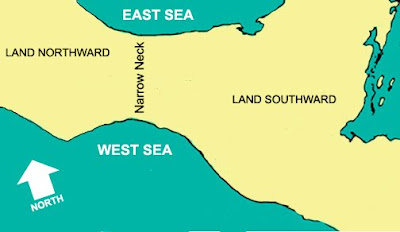The Hebrew word “Erev,” which means evening, shares a common root with the word “west.” However, trying to translate Hebrew accurately is an interesting exercise and often leads to inaccuracies and misunderstandings. Take, for instance, the Hebrew phrase “Ben Ha'arbayim" (Leviticus 23:5) which literally means “between the two evenings,” but has lent itself to several interpretations, the most important ones being 1) the day beginning the previous evening, which could be the daylight hours between the two evenings, 2) meaning between sunset and night, or 3) between noon and evening. There has been much controversy over these different interpretations through the years.
This was shown in the last post with the word “qudem” and is also true with the word “ahor,” another word Mesoamerican and Great Lakes theorists like to cite as meaning “back,” “after,” or “hinder,” as well as in some instances, means “west.” In the Qabbalah (which is an interpretation key—either art or theory—of the Torah) used in contradistinction (a distinction in contrast) to “anpin” (apprehensible portion of God, that is kindness, severity, mercy, victory, majesty, and foundation, in the Kabbalistic Zohar, which is the foundation of Jewish mystical thought) can mean “face,” taken from a Chaldean word from the Macroprosopus (Chaldean equivalent of the Jewish Kaballah), and is also spelled 'anaph, in Hebrew (meaning God-like anger).
The point of this is to show that when one tries to use Hebrew words to make a point, the very act of using ancient Hebrew is suspect itself—for Hebrew is not spoken or interpreted as it once was and much of the original meanings have been lost. To sttribute a particular meaning to a word or phrase often leads to misunderstandings and misinterpretations.
 The Mesoamerican theorist must change the scriptural record directions in order to match their model which is 90º off from being north and south as Mormon describes the land
The Mesoamerican theorist must change the scriptural record directions in order to match their model which is 90º off from being north and south as Mormon describes the landHowever, this does not stop Mesoamerican and Great Lakes theorists from bandying about words as if they are completely and specifically understood from their Hebrew origins. The fact is, “east” is referred to as “east” and “west” is referred to as “west” in Hebrew—and it always has been. The root of words is seldom helpful in understanding in modern terms a word of antiquity.
Take the word “west” today. We all know that this means the cardinal point of the compass 90-degrees to the left of north; however, it has over the past decades meant those countries of the western world (western Europe, Britain, Scandinavia, United States, Canada, etc.) who have fought against Germany, Italy and Japan. Before World War II, the west included Germany and Italy, as it does today. Anciently, it meant Greece and Rome as opposed to Turkey and Palestine, the Greco-roman world as opposed to the Ottoman Empire, the Catholic Church empire as opposed to the Greek Orthodox Church, etc.
Despite all this, when someone speaks of West, meaning a direction, we do not think of Britain, the U.S. or parts of Europe. In fact, to the Western Hemispheric nations, Britain and Europe are in the east. Consequently, to cloud the issue, as Mesoamerican and Great Lake theorists so often do, that the Nephites did not understanding their directions because to them the West Sea would be to their “back” while the East Sea would be to the “front” or where they were facing, as it was in Palestine, it would be off 90º in Mesoamerica. Thus, according to these theorists, when the Nephites stood on the shores of their Mesoamerican Land of Promise, and looked inland, the sea “to their back” would be to the “south,” while the sea “to their front” would be “north”—and they could not tell the difference. This is John L. Sorenson’s theory for explaining why his Land of Promise is 90º off kilter with cardinal directions and why the Nephites used directions in the Book of Mormon that were 90º off from cardinal points in describing the Land Southward and the Land Northward.
Such is the irresponsible writing of the Mesoamerican and Great Lakes theorists.
(See the next post, “Narrow Neck of Land and the Fallacy of Mesoamerica’s Isthmus of Tehuantepec - Part III,” to continue the understanding of the Hebrew words used by Mesoamerican theorists to defend their model)




No comments:
Post a Comment